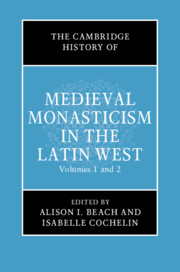Book contents
- The Cambridge History of Medieval Monasticism in the Latin WEST
- The New Cambridge History of Medieval Monasticism in the Latin West
- The Cambridge History of Medieval Monasticism in the Latin WEST
- Copyright page
- Contents
- Figures
- Contributors
- Acknowledgments
- Abbreviations
- 1 General Introduction
- Part I The Origins of Christian Monasticism to the Eighth Century
- Part II The Carolingians to the Eleventh Century
- 18 The Historiography of Central Medieval Western Monasticism
- 19 Sources for the History of Monasticism in the Central Middle Ages (c. 800–1100)
- 20 Questions of Monastic Identity in Medieval Southern Italy and Sicily (c. 500–1200)
- 21 Discerning “Reform” in Monastic Liturgy (c. 750–1050)
- 22 Monasticism, Reform, and Authority in the Carolingian Era
- 23 Carolingian Monastic Schools and Reform
- 24 Monastic Economics in the Carolingian Age
- 25 Missions on the Northern and Eastern Frontiers, c. 700–1100
- 26 Minsters and Monasticism in Anglo-Saxon England
- 27 Monastic Art and Architecture, c. 700–1100: Material and Immaterial Worlds
- 28 Monastic Daily Life (c. 750–1100): A Tight Community Shielded by an Outer Court
- 29 The Double Monastery as a Historiographical Problem (Fourth to Twelfth Century)
- 30 Interactions between Monks and the Lay Nobility (from the Carolingian Era through the Eleventh Century)
- 31 Monastic Reform from the Tenth to the Early Twelfth Century
- 32 Monastic Canon Law in the Tenth, Eleventh, and Twelfth Centuries
- 33 Eastern Influence on Western Monasticism, 850–1050
- Part III The Long Twelfth Century
- Part IV Forms of Monasticism in the Late Middle Ages
- Index
- References
23 - Carolingian Monastic Schools and Reform
from Part II - The Carolingians to the Eleventh Century
Published online by Cambridge University Press: 16 January 2020
- The Cambridge History of Medieval Monasticism in the Latin WEST
- The New Cambridge History of Medieval Monasticism in the Latin West
- The Cambridge History of Medieval Monasticism in the Latin WEST
- Copyright page
- Contents
- Figures
- Contributors
- Acknowledgments
- Abbreviations
- 1 General Introduction
- Part I The Origins of Christian Monasticism to the Eighth Century
- Part II The Carolingians to the Eleventh Century
- 18 The Historiography of Central Medieval Western Monasticism
- 19 Sources for the History of Monasticism in the Central Middle Ages (c. 800–1100)
- 20 Questions of Monastic Identity in Medieval Southern Italy and Sicily (c. 500–1200)
- 21 Discerning “Reform” in Monastic Liturgy (c. 750–1050)
- 22 Monasticism, Reform, and Authority in the Carolingian Era
- 23 Carolingian Monastic Schools and Reform
- 24 Monastic Economics in the Carolingian Age
- 25 Missions on the Northern and Eastern Frontiers, c. 700–1100
- 26 Minsters and Monasticism in Anglo-Saxon England
- 27 Monastic Art and Architecture, c. 700–1100: Material and Immaterial Worlds
- 28 Monastic Daily Life (c. 750–1100): A Tight Community Shielded by an Outer Court
- 29 The Double Monastery as a Historiographical Problem (Fourth to Twelfth Century)
- 30 Interactions between Monks and the Lay Nobility (from the Carolingian Era through the Eleventh Century)
- 31 Monastic Reform from the Tenth to the Early Twelfth Century
- 32 Monastic Canon Law in the Tenth, Eleventh, and Twelfth Centuries
- 33 Eastern Influence on Western Monasticism, 850–1050
- Part III The Long Twelfth Century
- Part IV Forms of Monasticism in the Late Middle Ages
- Index
- References
Summary
Monastic communities in the post-Roman world and the Carolingian age, often despite themselves, became major forces in the creation of a new European culture. Perhaps nowhere better can the crucial role that monks played in fashioning the civilization of the first Europe be observed than when they established and maintained schools and developed techniques and programs for learning when no other institution in the West was doing so.
- Type
- Chapter
- Information
- The Cambridge History of Medieval Monasticism in the Latin West , pp. 450 - 465Publisher: Cambridge University PressPrint publication year: 2020



